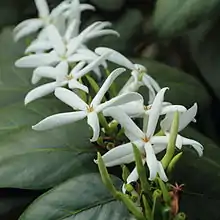Ramosmania rodriguesi
Ramosmania rodriguesi (café marron) is a tree native to the island of Rodrigues in the Indian Ocean.
| Ramosmania rodriguesi | |
|---|---|
 | |
| Ramosmania rodriguesi in cultivation at the Royal Botanic Gardens, Kew | |
| Scientific classification | |
| Kingdom: | |
| (unranked): | |
| (unranked): | |
| (unranked): | |
| Order: | |
| Family: | |
| Subfamily: | |
| Tribe: | |
| Genus: | |
| Species: | R. rodriguesi |
| Binomial name | |
| Ramosmania rodriguesi Tirveng. | |
History
It was thought Ramosmania rodriguesi was extinct until a single surviving tree was spotted by a schoolboy in 1979, who was shown a drawing of the plant by his teacher. The only image of the plant was made in 1877, by a European visitor, passing through Rodrigues. By the 1950s, it was presumed to be extinct. In the 1970s, a specimen was discovered; cuttings were taken to Kew Gardens, and although the plant regularly flowered, it never produced seed until horticulturist Carlos Magdalena discovered how to make the male plant bear female flowers.
In 2003 the café marron bore its first fruit with viable seeds. Slow but steady efforts have been made to grow more café marron trees and speed up the pollination process.[2] Ramosmania rodriguesi is a Critically endangered plant species.
References
- World Conservation Monitoring Centre (1998). "Ramosmania rodriguesi". IUCN Red List of Threatened Species. 1998. Retrieved 11 February 2014.
- Krulwich, Robert (2006-03-28). "The Little Coffee Plant that Wouldn't Die". National Public Radio. Retrieved 2007-07-21.
